Wikipedia:Picture of the day/April 2023
|
Featured picture tools: |
These featured pictures, as scheduled below, appeared as the picture of the day (POTD) on the English Wikipedia's Main Page in April 2023. Individual sections for each day on this page can be linked to with the day number as the anchor name (e.g. [[Wikipedia:Picture of the day/April 2023#1]] for April 1).
You can add an automatically updating POTD template to your user page using {{Pic of the day}} (version with blurb) or {{POTD}} (version without blurb). For instructions on how to make custom POTD layouts, see Wikipedia:Picture of the day.
April 1
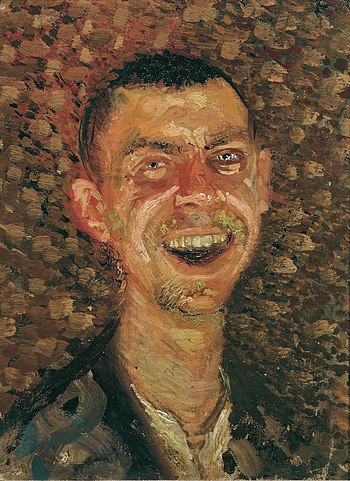
|
Richard Gerstl (1883–1908) was an Austrian painter and draughtsman known for his expressive and psychologically insightful portraits, his lack of critical acclaim during his lifetime, and his affair with the composer Arnold Schoenberg's wife. At the Academy of Fine Arts Vienna, Gerstl studied under the notoriously opinionated and difficult Christian Griepenkerl. He began to reject the style of the Vienna Secession and what he felt was "pretentious" art. For the summers of 1900 and 1901, Gerstl studied under the guidance of Simon Hollósy in Nagybánya. Inspired by the more liberal leanings of Heinrich Lefler, Gerstl once again attempted formal education. His refusal to participate in a procession in honor of Emperor Franz Joseph I of Austria further ostracized him and led to his departure; he felt that taking part in such an event was "unworthy of an artist". Gerstl painted this oil-on-canvas laughing self-portrait in an Expressionist style in the year of his death by suicide. The painting is now housed in the Österreichische Galerie Belvedere in Vienna. Painting credit: Richard Gerstl
Recently featured:
|
April 2
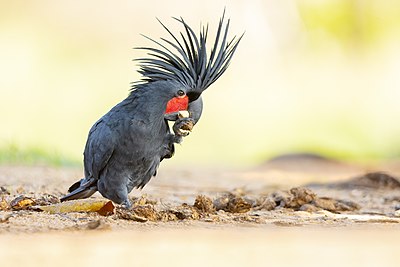
|
The palm cockatoo (Probosciger aterrimus) is a bird in the family Cacatuidae native to New Guinea, the Aru Islands, and Cape York Peninsula in Queensland. It has a very large black beak and prominent red cheek patches. This individual was photographed near Lockhart River in Queensland. Photograph credit: JJ Harrison
Recently featured:
|
April 3

|
The Galle Lighthouse is an onshore lighthouse in Galle, Sri Lanka. The oldest light station in the country, it is operated and maintained by the Sri Lanka Ports Authority. The first lighthouse in the area was built by the British in 1848 using cast-iron plates, but was destroyed by fire in 1936. The current 26.5-metre-high (87 ft) concrete lighthouse was built in 1939, around 100 metres (300 ft) from the original. This photograph of the Galle Lighthouse was taken in January 2020. Photograph credit: Alexander Savin
Recently featured:
|
April 4

|
The Boeing F-15EX Eagle II is an American multirole all-weather strike fighter manufactured by Boeing Defense, Space & Security. Derived from the McDonnell Douglas F-15 Eagle and first conceived in 2018, the F-15EX is not expected to survive against modern air defenses by 2028, but has the capability to perform homeland and airbase defense, enforce no-fly zones against limited air defenses, and deploy standoff munitions. The aircraft made its maiden flight in February 2021, and as of 2023 has a total planned fleet size of up to 104. This F-15EX, from the United States Air Force's 40th Flight Test Squadron, was photographed flying over northern California during an aerial-refueling operation in May 2021. Photograph credit: Ethan Wagner
Recently featured:
|
April 5
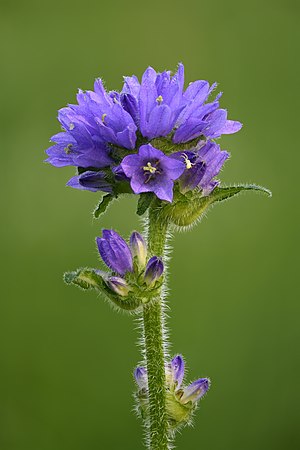
|
Campanula cervicaria, also known as the bristly bellflower, is a species of flowering plant in the bellflower family, Campanulaceae. Native to Scandinavia and central Europe, C. cervicaria has also become naturalised in parts of the U.S. state of Minnesota. Its natural habitat is woodland edges, hillside meadows, dry meadows and banks, and it also flourishes where soil has been disturbed, for example after slash-and-burn or forest clearance. The plant has a hairy stem, with light blue flowers about 1 to 2 centimetres (0.4 to 0.8 in) long and grouped together. This C. cervicaria flower was photographed in Keila, Estonia. Photograph credit: Ivar Leidus
Recently featured:
|
April 6

|
|
Landscape Arch is a natural rock arch in Arches National Park in the U.S. state of Utah. With a length of 290.1 feet (88.4 m), it is the longest natural arch in the park and the United States, and the fifth-longest in the world. Landscape Arch was named by Frank Beckwith, who explored the area in the winter of 1933–34 as the leader of a scientific expedition. Photograph credit: Thomas Wolf
Recently featured:
|
April 7
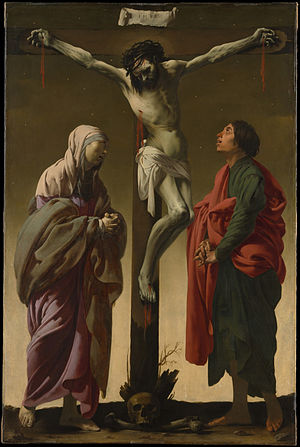
|
The Crucifixion with the Virgin and St John is an oil painting by the Dutch artist Hendrick ter Brugghen, probably painted around 1625 as an altarpiece for a Catholic clandestine church likely located in Utrecht in the Calvinist Dutch United Provinces. The scene is taken from the account of the crucifixion of Jesus in the Gospel of John, and depicts Jesus being mourned by his mother Mary and John the Apostle. At the base of the cross are bones, traditionally identified as those of Adam. The scene is set in an atmosphere of deep dusk with stars visible in the background. The painting was not known until it was discovered in a bombed-out church in South Hackney, London, in 1956. Initially unrecognized, it was identified before an appearance at Sotheby's later that year. It was acquired by the Metropolitan Museum of Art in New York, where it now hangs. Painting credit: Hendrick ter Brugghen
Recently featured:
|
April 8

|
|
SpaceX CRS-8 was a Commercial Resupply Services mission to the International Space Station that launched on April 8, 2016, at 20:43 UTC. It was the twenty-third flight of a Falcon 9 rocket, the tenth flight of a Dragon cargo spacecraft, and the eighth operational mission contracted to SpaceX by NASA under the Commercial Resupply Services program. After boosting the payload on its orbital trajectory, the rocket's first stage re-entered the denser layers of the atmosphere and landed vertically on the ocean landing platform Of Course I Still Love You nine minutes after liftoff (as pictured in this photograph), thus achieving a long-sought-after milestone in the SpaceX reusable launch system development program. Photograph credit: SpaceX
Recently featured:
|
April 9

|
The Church of the Redeemer is a church of the Anglican Church of Canada in Toronto, Canada, located at the intersection of Bloor Street and Avenue Road. Dedicated to Christ the Redeemer, the church was founded in 1871, when the area was still on the fringe of the city. The Gothic Revival building opened in 1879. The 20th-century high-rise buildings behind the church in this photograph are 21 Avenue Road (blue-gray, 1971) and 150 Bloor Street West (yellow-brown, 1981). Photograph credit: Maksim Sokolov
Recently featured:
|
April 10

|
|
Project Mercury was the first human-spaceflight program of the United States, running from 1958 through 1963. It was one of the first projects of NASA, which was created as a response to the Soviet Union's 1957 launch of Sputnik 1, the first satellite in Earth orbit. The program's goals were to orbit a crewed spacecraft around Earth, investigate the pilot's ability to function in space, and to recover both pilot and spacecraft safely. The Soviet Union won the race to put the first human into orbit when Yuri Gagarin traveled in Vostok 1 in 1961, while the US launched its first astronaut on a suborbital flight in the same year, and achieved crewed orbital flight in 1962 when John Glenn made three orbits around the Earth. The Mercury project's missions were followed by millions on radio and television around the world, and it laid the groundwork for Project Gemini, which carried two astronauts in each capsule and perfected space docking maneuvers essential for crewed lunar landings in the subsequent Apollo program, announced a few weeks after the first crewed Mercury flight. This NASA illustration compares the relative sizes and launch positions of the spacecraft and rockets of Project Mercury (small) with those of Gemini (medium) and Apollo (large). Illustration credit: Davis Paul Meltzer
Recently featured:
|
April 11

|
An oriental rug is a heavy textile made for a variety of utilitarian and symbolic purposes and originating from a region known as the Rug Belt, which stretches from Morocco across North Africa, the Middle East, and into Central Asia and northern India. The rugs can be pile-woven or flat-woven without pile, using various materials such as silk, wool, cotton, jute and animal hair. The origin of the oriental rug is unknown, although it is likely to have developed from earlier floor coverings made of felt. This French poster, titled "A La Place Clichy" and produced around 1891 to advertise oriental rugs, features a lithograph by the Swiss artist Eugène Grasset. Illustration credit: Eugène Grasset; restored by Adam Cuerden
Recently featured:
|
April 12
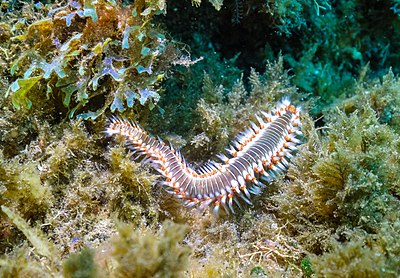
|
Hermodice carunculata, the bearded fireworm, is a type of marine bristleworm belonging to the Amphinomidae family, native to the tropical Atlantic Ocean and the Mediterranean Sea. They are usually 15 centimetres (6 inches) in average length, but can reach up to 30 centimetres (12 inches). This bearded fireworm was photographed in the Garajau Marine Nature Reserve in Madeira, Portugal. Photograph credit: Diego Delso
Recently featured:
|
April 13
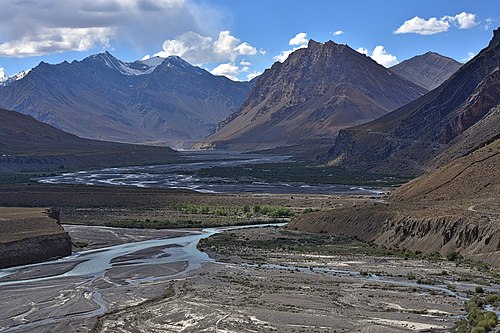
|
|
Spiti is a high-altitude cold desert in the Western Himalayas in India. "Spiti" means "the middle land", between Tibet and India. The region is above the tree line, with only shrubs and a few scattered stunted trees. In the upper valley, the braided Spiti River flows in narrow channels in a very wide river bed, as seen in this photograph, taken just above Kaza, the largest town in Spiti. In the lower valley, the river meanders through gorges 10 to 130 metres (33 to 427 ft) deep that it has cut in the sedimentary deposits. The Moravian geologist Ferdinand Stoliczka discovered a major geological formation near the village of Mud in the 1860s, and identified a number of layers or successions. The people of Spiti follow Tibetan Buddhism, and their culture is similar to those of neighbouring Tibet and Ladakh. The region is known for adventure tourism, trekking and mountaineering. Photograph credit: Timothy A. Gonsalves
Recently featured:
|
April 14

|
|
C/2022 E3 (ZTF) is a long-period comet from the Oort cloud that was discovered by the Zwicky Transient Facility in March 2022. The comet has a bright green glow around its nucleus, due to the effect of sunlight on diatomic carbon and cyanogen. Its comet nucleus is estimated to be about 1 kilometre (0.62 mi) in size, rotating every 8.5 to 8.7 hours. Its tails of dust and gas extended for millions of kilometres and, during January 2023, an anti-tail was also visible. The comet reached perihelion on 12 January 2023, at a distance of 1.11 AU (166 million km; 103 million mi), and its closest approach to Earth was on 1 February 2023, at a distance of 0.28 AU (42 million km; 26 million mi). The comet reached magnitude 5 during this approach, and was visible with the naked eye under moonless dark skies. This photograph of C/2022 E3 (ZTF), released by the Italian National Institute for Astrophysics, was taken on 27 January 2023. Photograph credit: Alessandro Bianconi
Recently featured:
|
April 15
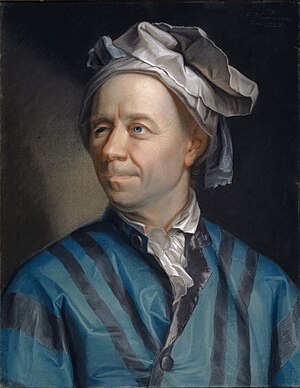
|
Leonhard Euler (15 April 1707 – 18 September 1783) was a Swiss mathematician, physicist, astronomer, geographer, logician and engineer. He founded the studies of graph theory and topology, and made pioneering and influential discoveries in many other branches of mathematics such as analytic number theory, complex analysis and infinitesimal calculus. Euler introduced much of modern mathematical notation and terminology, including the notion of a mathematical function. He is also known for his work in mechanics, fluid dynamics, optics, astronomy and music theory. This pastel-on-paper portrait of Euler was painted by the Swiss painter Jakob Emanuel Handmann in 1753, and is now in the collection of the Kunstmuseum Basel. Painting credit: Jakob Emanuel Handmann; image retouched by Bammesk
Recently featured:
|
April 16
|
BASF is a European multinational chemical company and the largest chemical producer in the world. The group comprises subsidiaries and joint ventures in more than 80 countries and operates six integrated production sites and 390 other production sites in Europe, Asia, Australia, the Americas and Africa. This panoramic photograph, taken in January 2023, shows the northern part of BASF's headquarters in Ludwigshafen, Germany, as seen from the east bank of the Rhine. Photograph credit: Norbert Nagel
Recently featured:
|
April 17
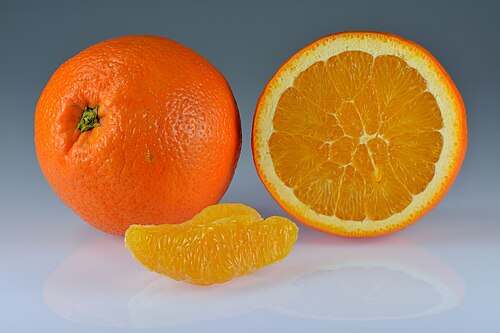
|
|
The orange is a fruit of various citrus species in the family Rutaceae, primarily the cultivar Citrus × sinensis, also known as the sweet orange to distinguish it from C. × aurantium, the bitter orange. The sweet orange is a hybrid between the pomelo (C. maxima) and the mandarin (C. reticulata), with the pomelo being the chloroplast genome and maternal line. The orange originated in a region encompassing south China, northeast India, and Myanmar, and the earliest mention of the sweet orange found in Chinese literature dates from 314 BC. The sweet orange reproduces asexually (apomixis through nucellar embryony); varieties of sweet orange arise through mutations. The whole genome has been sequenced. This photograph, depicting a whole orange, a halved orange, and a peeled orange segment, was focus-stacked from eleven images. Photograph credit: Ivar Leidus
Recently featured:
|
April 18

|
|
B-515, sometimes known as U-434 after her pennant number, is a Tango-class submarine that served in the Soviet Navy and later the Russian Navy. Built in 1976 in Nizhny Novgorod, the submarine remained in active service until 2001. She was used for hunting, espionage, and patrol purposes, operated by a 78-man crew. Now docked in Hamburg, Germany, she is open to the public as a museum ship. This 2020 photograph shows a panorama of B-515's interior. Photograph credit: Tim Rademacher
Recently featured:
|
April 19

|
The Balkan fritillary (Boloria graeca) is a butterfly in the family Nymphalidae. It is found in the southern central Alps and the mid- to high-altitude Balkans. This Balkan fritillary of the subspecies B. g. balcanica was photographed in Yastrebets, in the Rila Mountains of Bulgaria, in 2017. Photograph credit: Charles J. Sharp |
April 20

|
Urban agriculture, urban farming, or urban gardening is the practice of cultivating, processing, and distributing food in or around urban areas. Urban agriculture can reflect varying levels of economic and social development. It may be a social movement for sustainable communities, where organic growers, "foodies", and "locavores" form social networks founded on a shared ethos of nature and community holism. For others, food security, nutrition, and income generation are key motivations for the practice. In both scenarios, more direct access to fresh vegetables, fruits, and meat products through urban agriculture can improve food security and food safety. This photograph depicts urban agriculture in the form of a roof garden at Essex Crossing in Manhattan, New York City. Among the plants grown are tomatoes, chili peppers, lettuce, herbs, carrots and beetroots. Photograph credit: Rhododendrites
Recently featured:
|
April 21

|
Selimiye Mosque is a mosque in North Nicosia in the de facto state of Northern Cyprus, and the principal Islamic place of worship on the island of Cyprus. It was constructed as a Christian church known as the Cathedral of Saint Sophia, which was built on the site of an earlier Byzantine church, and was consecrated in 1326. It was converted to a mosque in 1570, following the 50-day siege of Nicosia, when the area became part of the Ottoman Empire. A pair of minarets and other Islamic features were added at that time. Photograph credit: Alexander Savin
Recently featured:
|
April 22
|
The Orchid Pavilion Gathering, also known as the Lanting Gathering, was a cultural and poetic event held in China in 353, during the Jin dynasty of the Six Dynasties era. During the Spring Purification Festival, forty-two literati met at the Orchid Pavilion (Lanting) on Mount Kuaiji, near present-day Shaoxing in Zhejiang. This 7th-century scroll, now at the Palace Museum in Beijing, is considered to be the best of the surviving copies of the Lantingji Xu, written by Wang Xizhi as a preface to the collection of poems produced at the Orchid Pavilion Gathering. Copies of the work were made throughout Chinese history. The text reads, in part: "Reading past compositions, I can recognize the same melancholy from the ancients. I can only lament before their words without being able to verbalize my feelings. [...] The future generations will look upon us, just like we look upon our past. How sad! Hence, we record the people presented here today and their works; even though time and circumstances will be different, the feelings expressed will remain unchanged." Calligraphy credit: Feng Chengsu, after Wang Xizhi
Recently featured:
|
April 23
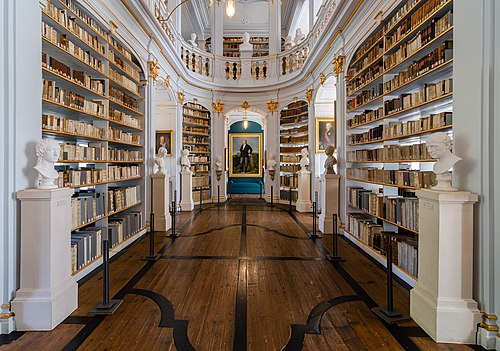
|
|
The Duchess Anna Amalia Library in Weimar, Germany, houses a major collection of German literature and historical documents. In 1991, the tricentennial of its opening to the public, the Ducal Library was renamed for Duchess Anna Amalia of Brunswick-Wolfenbüttel. Today, the library is a public research library for literature and art history and contains over 1,000,000 items, 150,000 of which are available for open use and borrowing. The main focus of the collection is German literature from the Classical and the late Romantic eras. The library was inscribed on UNESCO's list of World Heritage Sites as part of the Classical Weimar site because of its testimony to the global cultural importance of Weimar in the late 18th and early 19th centuries, during the Weimar Classicism movement. This photo is from the Rococo hall. Photograph credit: Steffen Schmitz
Recently featured:
|
April 24
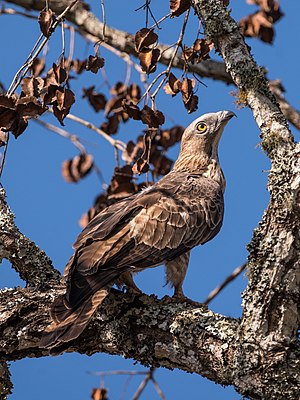
|
The crested honey buzzard (Pernis ptilorhynchus), also known as the Oriental honey buzzard, is a bird of prey in the family Accipitridae. Its size ranges from 57 to 60 centimetres (22 to 24 in). The name is derived from its diet, which consists mainly of the larvae of bees and wasps, extracted from honeycombs. It has several adaptations for this diet, including an elongated head for foraging on underground nests and a groove in the tongue for feeding on honey. A mass of short, dense feathers on the head and neck protect against stinging attacks by social wasps. The crested honey buzzard is a year-round resident in Southeast Asia and the Indian subcontinent. Some birds migrate to Siberia and Japan during the summer for breeding. This crested honey buzzard was photographed in Mudumalai National Park, India. Photograph credit: Timothy A. Gonsalves
Recently featured:
|
April 25

|
Chandra Shumsher Jung Bahadur Rana (1863–1929) was a member of the Rana dynasty who served as Prime Minister of Nepal from 1901 until his death. He came to power after successfully deposing his liberal and reformist brother Dev Shumsher. Although generally perceived as despotic and conservative, he is credited with reforms including the abolition of slavery and the Nepal–Britain Treaty of 1923, which recognised Nepal as an independent nation and an ally of Britain. This photograph of Chandra Shumsher, wearing the robes of the Order of the Star of India, was taken in 1908 during a visit to Europe. Photograph credit: Madan Puraskar Pustakalaya; restored by Captain Medusa
Recently featured:
|
April 26
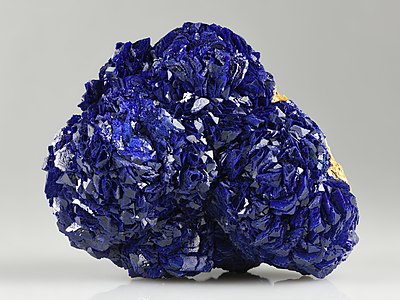
|
Azurite is a soft, deep-blue mineral produced by the weathering of copper-ore deposits. It is a basic carbonate with the chemical formula Cu3(CO3)2(OH)2, and has been known since ancient times, being mentioned in Pliny the Elder's Natural History under the Greek name kuanos and the Latin name caeruleum. These azurite crystals, covering a 4.0 cm × 3.0 cm × 2.0 cm (1.57 in × 1.18 in × 0.79 in) matrix with a little malachite, were found in a lode in La Sal, Utah. This photograph was focus-stacked from 55 separate images. Photograph credit: Ivar Leidus
Recently featured:
|
April 27
|
The monsoon of South Asia is one of the world's monsoons, affecting the Indian subcontinent. Because of its effect on agriculture, on flora and fauna, and on the climates of nations including Bangladesh, Bhutan, India, Nepal, Pakistan and Sri Lanka, the monsoon is one of the most anticipated, tracked and studied weather phenomena in the region. The southwest monsoon generally starts on the western coast of India at the beginning of June, and runs through to the beginning of October. Its cause is only partly understood and it is notoriously difficult to predict, with several theories proposed to explain its origin and process. These two panoramic photographs, taken three months apart in 2010 from the same location, show a view of the Western Ghats in Maharashtra, India, during the dry season in late May (top) and during the peak of the South Asian monsoon in late August (bottom). Photograph credit: Arne Hückelheim
Recently featured:
|
April 28

|
Gabrielle Ray (28 April 1883 – 21 May 1973) was an English stage actress, dancer and singer, best known for her roles in Edwardian musical comedies. She was considered one of the most beautiful actresses on the London stage and became one of the most photographed women in the world. In the first decade of the 20th century, she had a good career in musical theatre. After an unsuccessful marriage, Ray returned to the stage, but she never recovered the fame that she had enjoyed. She later struggled with depression and spent her last 37 years in a mental hospital. This photograph of Ray was taken around 1910. Photograph credit: Foulsham and Banfield; restored by Adam Cuerden
Recently featured:
|
April 29
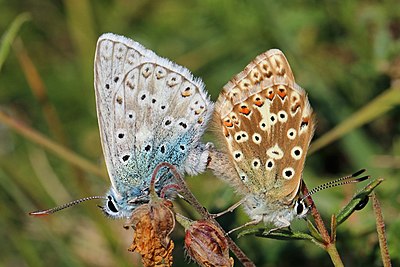
|
The chalkhill blue (Lysandra coridon) is a species of butterfly in the family Lycaenidae. It is a small butterfly that can be found throughout the Palearctic realm, where it occurs primarily in grasslands rich in chalk. Males are a pale blue colour, while females are dark brown; both have chequered fringes around their wings. This mating pair of chalkhill blues was photographed at Aston Rowant National Nature Reserve in Oxfordshire, England. The species breeds and produces a new generation only once per year. Photograph credit: Charles J. Sharp
Recently featured:
|
April 30
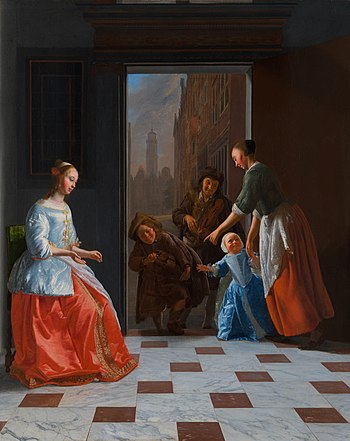
|
Street Musicians at the Door is an oil-on-canvas painting by the Dutch Golden Age artist Jacob Ochtervelt, painted in Rotterdam in 1665. It depicts a mother, child and maid from a wealthy family interacting with two musicians at the door of their house. The musicians are playing a violin and a hurdy-gurdy. It is an example of an "entrance hall painting", a genre pioneered by Ochtervelt. The work is now in the collection of the Saint Louis Art Museum in St. Louis, Missouri. Painting credit: Jacob Ochtervelt
Recently featured:
|
Picture of the day archives and future dates




